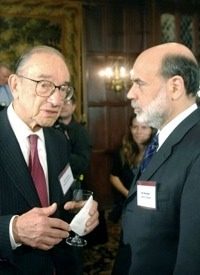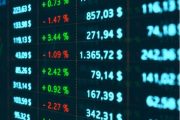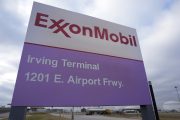
In its attempt to glorify “the 10 who shaped the U.S. economy the most since 2000”, ABC News did a great favor for those interested in the interconnections among the “elite” who are impacting the current world economic and political scene.
Naturally, much was left unsaid about these “captains”, especially regarding their connections to the elite currently in charge. In order, then, here is a brief look at each of these “10 who shaped the U. S. economy”:
Number One: Henry Paulsen:
Best known for the Paulsen Plan to bail out financial institutions during the September, 2008 “meltdown”, Paulsen’s list of connections with the elite is remarkable:
1. Before being appointed Treasury Secretary by President George Bush in June, 2006, he had been CEO of Goldman Sachs, a huge investment banking firm.
2. As CEO of Goldman Sachs, he succeeded Jon Corzine (former senator from and current governor of New Jersey), who succeeded Stephen Friedman (chairman of President Bush’s Foreign Intelligence Advisory Board), who succeeded Robert Rubin (chairman of the National Economic Council, and later Treasury Secretary under President Clinton).
3. He initiated and led the U.S.-China Strategic Economic Dialogue (a forum to “address” areas of “strategic and economic interest”). In July, 2008, The Daily Telegraph reported that Paulsen “has intimate relations with the Chinese elite, dating from his days at Goldman Sachs when he visited [China] more than 70 times”
4. Paulson is a member of the Council on Foreign Relations.
Despite his connections with the elite, he failed to see the oncoming economic crisis. In the spring of 2007, Paulson said that “an open, competitive, and liberalized financial market can effectively allocate scare resources in a manner that promotes stability and prosperity far better than government intervention”. In August of that same year, Paulson explained that the U. S. subprime mortgage fallout “remained largely contained”. In July, 2008, Paulson continued his assurances: “It’s a safe banking system, a sound banking system. Our regulators are on top of it. This is a very manageable situation.” In fact, on August 10th, 2008, Paulson told Meet the Press that he had no plans to inject any capital into Fannie Mae or Freddie Mac. Both institutions went into receivership less than a month later.
As a member of the elite, however, Paulson knows that coercion and threats are the best way to solve such problems. In October of 2008, in a meeting with 9 major banks, Paulson said the bankers would be forced to accept government bailout money, whether they wanted it or not. His ultimatum: “If a capital infusion is not appealing, you should be aware that your regulator will require it in any circumstance”. His totalitarian mindset was further confirmed in Section 8 of his “Paulson Plan”: “Decisions by the Secretary…are non-reviewable…and may not be reviewed by any court of law or any administrative agency”.
Paulson has become a wealthy man. His income in 2005 was $35 million, and his net worth has been estimated at over $700 million.
Number Two: Ben Bernanke
Some of Bernanke’s early connections to the elite began while he was a student at Harvard University.
His classmates included such luminaries as former Treasury Secretary Robert Rubin, Lloyd Blankfein (CEO of Goldman Sachs), and Representative Barney Frank (Representative from Massachusetts). His thesis advisor was Stanley Fischer, the current Governor of the Bank of Israel.
He is Chairman of the Federal Reserve System, America’s central bank where he serves with other members of the elite, Donald Kohn, Kevin Warsh, Elizabeth Duke, and Daniel Tarullo, member of the Council on Foreign Relations.
All of these connections with the elite have served him well over the years, and he appears to be headed for reappointment as the head of the Fed for another 4 years.
Number Three: Timothy Geithner
Much is available about Geithner’s credentials and history as a full-fledged member of the political elite in America. But some connections are surprising. For instance, Geithner’s father, Peter F. Geithner, was the director of the “Asia” program for the Ford Foundation (corporate member of the CFR) in the 1990’s. Even more interesting, however, is that in the ’80’s, Peter oversaw the Ford Foundation’s programs in Indonesia, which were being developed by Ann Dunham, President Obama’s mother.
And Geithner’s maternal grandfather, Charles F. Moore, was an advisor to President Eisenhower, and served as Vice President of Public Relations for the Ford Motor Company.
Early in his career, Geithner worked for Kissinger Associates.
As he moved up the ladder of the elites, in 1998 he became Under Secretary of the Treasury for International Affairs, working closely with Robert Rubin and Lawrence Summers. Both are members of the Council on Foreign Relations. Although Geithner’s mentor was Summers, he was really Rubin’s protégé.
Number Four: Alan Greenspan
Although a follower of Ayn Rand in the early ‘50’s and initially favored a gold standard, he soon connected with the elite. He received degrees in economics from New York University, and Columbia University, where he studied under Arthur Burns, a member of the CFR, who later became Fed chairman from 1970 to 1978.
His education now complete, Greenspan was appointed Chairman of the Federal Reserve where he served from 1987 to 2006. He was a director of the Council on Foreign Relations from 1982 to 1988, and joined the Group of Thirty in 1984.
Number Five: Hank Greenberg
His links to the elite began with Cornelius Vander Starr, an operative of the OSS (Office of Strategic Services, precursor to the CIA). In 1962, Starr appointed Greenberg as head of AIG’s North American operations, and in 1968 picked him as his successor at AIG. Greenberg became a client of Kissinger Associates, and a personal friend of Henry Kissinger. KA “advised” Greenberg on affairs in a number of countries, and Greenberg appointed Kissinger as Chairman of AIG’s International Advisory Board.
Greenberg and his two sons, Jeffrey and Evan eventually controlled a large portion of the insurance industry.
Currently, Greenberg is Honorary Vice Chairman and Director of the Council on Foreign Relations and is a member of David Rockefellers’ Trilateral Commission, and is Trustee Emeritus of the Rockefeller University, founded by the Rockefeller family.
One of the keys to his influence among the elite is his position as Chairman of the Starr Foundation, where he oversees the disbursement of major financial support to academic, medical, cultural, and public policy institutions. Perhaps this explains why he retains his influence even after having been ousted from AIG amidst an accounting scandal in 2005.
Number Six: Sheila Bair
She entered government service through the General Counsel’s office of the former Department of Health, Education and Welfare, and was soon picked up by Senator Robert Dole (Republican, State of Kansas) as his Research Director, Deputy Counsel and Counsel in the early ’80’s.
From there she was appointed Commissioner and acting Chair of the Commodity Futures Trading Corporation. From there she worked at the Treasury Department, and then was appointed Chairwoman of the Federal Deposit Insurance Corporation by President George W. Bush.
Interestingly, Forbes magazine ranked Bair as the 2nd most powerful woman in the world. Forbes magazine is owned by Steve Forbes who was John McCain’s Economic Advisor during McCain’s presidential campaign in 2008.
Number Seven: Wen Jiabao
As the Premier of the State Council of the People’s Republic of China, Jiabao is ranked third in influence in the Chinese communist dictatorship.
According to the puff piece at Wikipedia, he is hard-working, soft-spoken, and respected. He is also a political survivor in a brutal communist dictatorship, with great influence in the West. For example, in 2003 he was invited by President George Bush to visit the White House, at which time he was able to persuade the President to issue a statement supporting Red China in its conflict with Taiwan. He also visited Japan, Australia, and Canada.
At the present time, Jiabao’s government holds between $1 and 2 trillion in U.S. Treasury debt.
Number Eight: Jamie Dimon
Jamie Dimon was invited into the inner circle of the elite by Sandy Weill, former owner and CEO of Citigroup. Weill’s journey from obscurity to prominence is available elsewhere, except to say that Weill was able to enlist the assistance of many insiders, as he acquired several well-known brokerage houses and investment firms — insiders such as Robert Rubin and Gerald Ford.
Naturally, it helped that both Weill and Dimon are members of the Council on Foreign Relations.
Dimon caught the attention of Weill when he graduated with an MBA from Harvard University in 1962. Turning down higher paying offers from Goldman Sachs, and Morgan Stanley, Dimon became an assistant to Weill at American Express. The next two decades saw enormous growth and influence as a result of these two working together, culminating in Weill’s ascension to CEO of Citigroup.
When that partnership dissolved in the late ’90’s, Dimon became CEO of Bank One, and then President of J. P. Morgan Chase in 2004 when it bought Bank One.
By 2008, Dimon was a Director of the New York Federal Reserve Board, and was involved in Morgan’s bailout (with government money) of Bear Stearns. There were rumors that Dimon was a candidate for the position of Treasury Secretary that President Obama eventually awarded to Timothy Geithner.
And now that Geithner is under pressure to resign, Dimon appears to be first on the list to take his place.
Number Nine: Ken Lewis
Lewis, CEO of Bank of America, may be the best example of a successful executive who did it the hard way — by connecting with an honorable mentor, Hugh McColl (prior B of A CEO), and working hard.
Starting as a bank analysis in 1969, Lewis worked closely with McColl during a time of enormous growth of the bank through acquisitions of other banks. Following McColl to the leadership role at the bank in 2001, Lewis moved the bank to its present position of prominence. Although criticized for acquiring Countrywide and Merrill Lynch in 2008 (and stripped of his position of Chairman), Lewis remains CEO at least through the end of the year.
Remarkably, Lewis has avoided (publicly, at least) memberships in any of the prominent Good Ol’ Boy networks (i.e., the Council on Foreign Relations, The Trilateral Commission, etc.).
Number Ten: Warren Buffett
Well-known for his business and investing acumen, Buffett built Berkshire Hathaway and his personal wealth without apparent strong insider connections to the elite until later in life.
Starting his B-H partnership in 1962, he didn’t start making investments into “insider” companies until 1973 when he began to acquire stock in the Washington Post, owned at the time by Katharine Graham. Graham was well-connected at the time, having married Philip Graham, a graduate of Harvard Law School and a clerk for Supreme Court Justice Felix Frankfurter. Her father, Eugene Meyer (who bought the Washington Post in 1933 at a bankruptcy auction) moved on to become head of the World Bank, leaving Graham to run and eventually become publisher of the paper in 1946. Buffett became close friends of Graham and became a member of the Post’s board of directors.
In 1987, Buffett purchased a 12 percent stake in Salomon, Inc. (CEO at the time was inside John Gutfreund). When Gutfreund left the company following an insider trading scandal, Buffett became CEO.
Buffett continued to make profitable investments in other well-known (often with significant insider connections) companies, such as Coca-Cola, AIG (see Hank Greenberg above), and most recently, Burlington Northern Santa Fe Corporation, which has links back to James J. Hill as the railroad “empire builder” in the late 19th Century.
Conclusion:
With one, or perhaps two, exceptions, talent, hard work, and connections have not only proven highly profitable for these “Captains," but have also shown that the “Good Ol’ Boy” network remains alive and well.
Photo of Alan Greenspan and Ben Bernanke: AP Images



